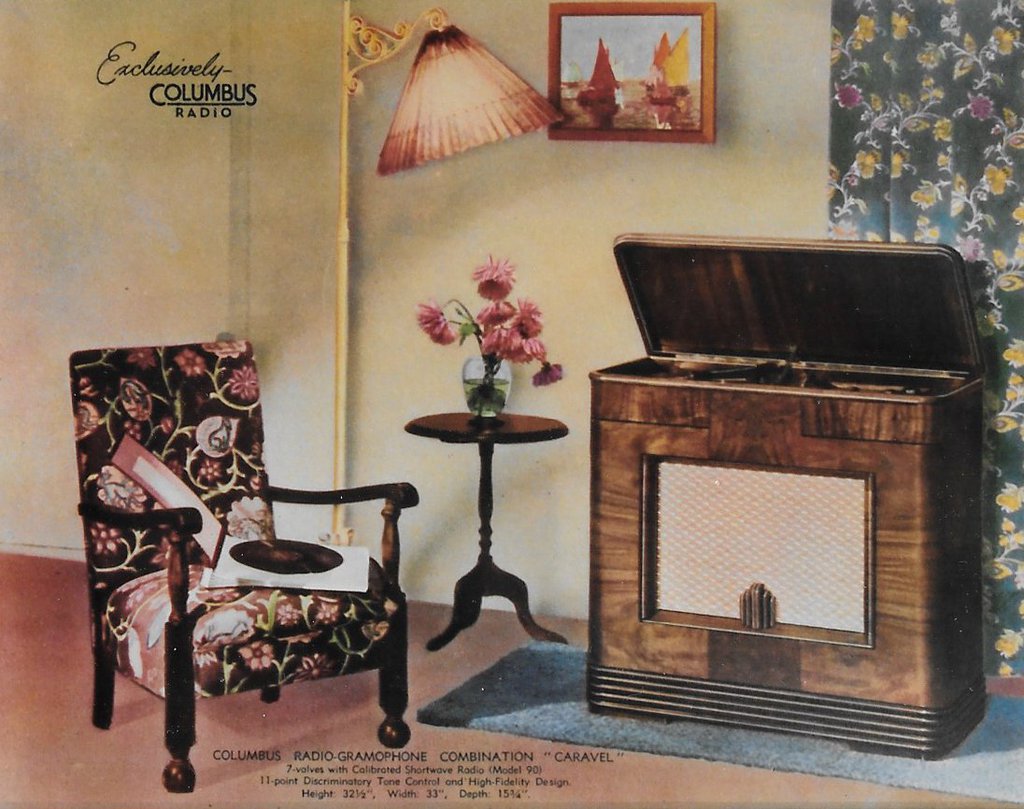Other radios based on the same chassis:
The model 90 followed the model 75 as the second high-end bandspread receiver from Radio Corp. There was some overlap between the model 75 finishing and the model 90 starting - and they were quite similar in chassis appearance although quite different in circuitry.
Unlike the model 75, the 90 had very few changes over its realtively long life. Cabinet options were wide-ranging from table-top sets to large statement-piece consoles and radiograms.
90 - 1942-1946
90S (AC-DC Series-String variant) - 1945 date on schematic - probably available from 1942 on
90W - 1947-1948
90X - 1949-1950


The 11-position tone control, the 'Columbus Electronic Ear' as is was known, was an advanced solution to try and help the listener get the best listening experience based on what they were listening to.
Note: the following feature from The Listener on March 8th 1946 misnames the 'Convoy' cabinet style as the 'Conway'.




Valves (6 + eye):
Early: 6K7G, 6J8G, 6B8G, 6J7G, 6F6G, 5Y3G, and 6U5 Magic Eye
Later: 6K7G, 6K8G, 6B8G, 6J7G, 6F6G, 5Y3G, and Y63 Magic Eye
Intermediate Frequency: 455kc/s
Frequency Bands: 5
Chassis Notes(most schematics can be clicked to download a full size version)
Bands:
1. Broadcast (550 - 1600kc/s)
2. Shortwave (6 - 18mc/s)
3. Shortwave (14.85 - 15.73mc/s)
4. Shortwave (11.65 - 12.2mc/s)
5. Shortwave (9.45 - 9.75mc/s)
Note: the capacitors used in the tone cct are oil-filled and are often found to be leaky after all these years, making a mess under the chassis. They are soldered into cups in the chassis and can be removed reasonably easily.
Sensitivity Tests
Volume control full on. Tone control position 5. Sensitivity based on x microvolts input to give 50mW standard output.
| Frequency | Input To: | Microvolts |
|---|---|---|
| 455kc/s | Grid 6B8 | 5000 |
| 455kc/s | Grid 6J8 | 80 |
| 1400kc/s | Antenna lead through dummy antenna | 2.5 |
| 1000kc/s | Antenna lead through dummy antenna | 3.0 |
| 600kc/s | Antenna lead through dummy antenna | 4.0 |
| 15Mc/s | Antenna lead through dummy antenna | 1.5 |
| 6Mc/s | Antenna lead through dummy antenna | 1.5 |
| Bandspread | Antenna lead through dummy antenna | 1.5 |


General Construction Notes for Radio Corporation of New Zealand Ltd:
The first digit of the serial number typically indicates the year of manufacture of RCNZ chassis' (although not the decade - that requires a little knowledge of the valves, construction, etc). Sets from around 1934 onwards were often (but not always) constructed in a distinctive pressed 'baking pan' style chassis, seemingly unique to RCNZ.
Model codes beginning with a 0, for example the model 051, are Osram valve versions of the model without the leading 0. Technically the 0 should be an O (for Osram), however the digit 0 was used throughout the site before this fact was discovered.
The E suffix indicates a magic eye option is fitted (in models which were available with or without, such as the model 25).
A and B suffixes appear to be simply updates to the current model, R also appears to be simply an updated model ('R'edesign, perhaps?)
P indicates either a permanent magnet speaker version of a model which also came with an electromagnet speaker (the model 26 for example), or a portable model (like the model 694P). This suffix was used in the mid 50's when Radio Corp was changing over.
N and M indicated miniature valve versions of a model which started with all (or a mix, ie: model 5) of larger valves. One of these two codes may indicate a transitional mixture of octal and miniature - clarification is required.
S often indicates a stereo model. It can also indicate 'self-biased' in the transition period between back-biased and self biased sets where there were models with both methods employed (53S for example)
Finally, other suffixes and prefixes make occasional appearances in the RCNZ lineup - like the 66W (a variant of the long-running model 66) and the 75XA (a 10-valve version of the model 75 with a separate amplifier chassis).
Model nicknames are often sourced from either newspaper advertising, company literature or the NZ Radio Traders Federation official trade-in price books (Particularly Courtenay models from this publication)
In 1954, model numbering changed, to begin with the number of valves (ie: 501 - 5 valves, 1006 - 10 valves, etc) although the final 2 digits don't appear to have much significance. Middle digits of 5 (portable) or 6 (mantle, including clock radio) are used on the AWA-designed plastic-cased sets.
| YEAR | MODEL NAME |
|---|---|
| 1942 | Courtenay model 90 |